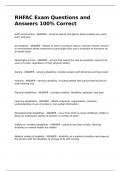RHFAC Exam Questions and
Answers 100% Correct
built environment - ANSWER - physical spaces and places where people live, work,
learn and play
accessibility - ANSWER - degree to which a product, device, activity, facility, service
or environment allows everyone to participate fully and is available to everyone on
an equal basis
Meaningful access - ANSWER - access that meets the real accessibility needs of all
users of a Site, regardless of their physical ability
Seeing - ANSWER - sensory disability, includes people with blindness and low vision
Hearing - ANSWER - sensory disability, includes people with partial hearing loss to
total hearing loss
Physical disabilities - ANSWER - includes mobility, flexibility, dexterity, and pain
Learning disabilities - ANSWER - affects acquision, organization, retention,
understanding or use of verbal or non-verbal information
Developmental disabilities - ANSWER - occur from birth or early childhood, inhibit or
delay an individual's ability to perform a number of tasks
Visible vs. invisible disabilities - ANSWER - physical are often visible, learning
disability or mental health are hidden
Medical model of disability - ANSWER - disability as a medical condition and expects
the person with the disability to change to fit with society
,Social model of disability - ANSWER - method of looking at the disability experience
considers an individual's needs in the context of wider society. Focuses on barriers
created by society
Mental health related - ANSWER - disorders that affect mood, thinking and
behaviour
Memory - ANSWER - affects storage, retention, and recollection of memories
Communication disabilities - ANSWER - impact speaking or understanding spoken
language, can overlap with other challenges such as learning difficulties, cognitive
challenges, or an aspect of autism spectrum disorders, mental health-related
problems, or hearing-related conditions
Barriers to Accessibility - ANSWER - Accessibility for Ontarians with Disabilities Act
identifies five barriers—attitudinal, architectural and physical, organizational or
systemic, information or communications, technology
CSA Group - ANSWER - develops accessibility standards (and others)
Rating Score - ANSWER - final percentage score on the rating scorecard calculated
by the total earned points divided by the available points, determines certification
level awarded
RHF accessibility certified - ANSWER - a site that has met the certification
prerequisite and achieved a final rating score of at least 60%
attitudinal barriers - ANSWER - behaviours, perceptions and assumptions that
discriminate against persons with disabilities
Assuming a person with a physical disability is not capable of being employed,
Assuming a person with hearing loss cannot effectively communicate socially or in a
work setting,
, Assuming that someone with vision loss cannot navigate public transportation, city
streets or even a filing cabinet,
Assuming that a person with mental health issues cannot handle stress.
Architectural or Physical - ANSWER - elements of buildings or outdoor spaces that
block or limit access to persons with disabilities,
Sidewalks, hallways, and doorways that are too narrow for a wheelchair, scooter or
walker,
Counters or desks that are too high for persons of short stature or someone using a
wheelchair, or other mobility device, to interact with staff or to carry out a
transaction,
Poor lighting that makes it difficult for a person with low vision to see or for
someone who lip-reads or uses sign language,
Doorknobs that are difficult to grasp for a person with arthritis, telephones that are
not equipped with telecommunications devices for people who are deaf or hard of
hearing,
lack of visual fire alarms could mean that a person with a hearing disability is
working in an area that is unsafe for them.
Organizational or Systemic - ANSWER - policies, procedures or practices that
discriminate and prevent people with disabilities from participating fully in an
opportunity available to others,
An employment equity program that does not provide a hiring process that is open
to people with disabilities:
No hiring forms/applications in Braille, large print or other alternative formats,
No telephone device for the deaf (TDD) so that people with hearing loss can talk
directly to HR staff,
Physically inaccessible offices,
Rigid office hours or dress codes
Information or communications barriers - ANSWER - happen when a person can't
easily understand information,
Print that is too small or in a font that is difficult to read,




